A number of hardware products are supported in HCA that are older or not commonly used anymore. HCA has designated them Legacy Devices. Support for them remains in HCA but, in order to reduce the complexity of the user interface, they have been hidden. To make the supporting user interface available for these products, select from the menu HCA - Properties and look on the legacy tab
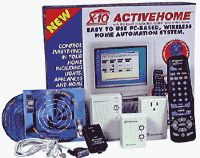
Note: HCA still contains support for the CM11 and support for the CM15 is also available.
So you purchased the ActiveHome box? Sure, who hasn't! At that price how can you go wrong. But while the lamp module and the remotes work fine and the CM11 is OK, the software is, well, less than expected, right? If you are still using the CM11 and ActiveHome you are wasting your money. Why? Because you have a lot of expensive hardware and you are not getting all the use out of it you can. It takes better software to do that. HCA is that software.
Since the CM11 has a memory, HCA can translate and download schedules to that memory. And the last piece of good news is that HCA will read your ActiveHome file and convert it into a HCA design file.
For more information about how HCA supports the CM11 see the CM11 Appendix which can be downloaded from the Documentation section.
Support for the CM11 is in the Limited, Standard, and Plus flavors of HCA.
NOTE: The newer CM15 is supported in HCA. See this.
 Top
Top
In HCA we are very pleased to support the Magic Module family of products manufactured by Elk Products, Inc.
The Magic Module is a small, yet powerful, piece of automation gear. It contains a processor with 16K of memory, 4 relays, and 4 analog inputs. It contains a connection point for an X10 interface (TW523 / PSC05) or a Access card / iButton reader. Each Magic Module makes available a 485 Bus connection so that more than one Magic Module can be connected to form a network of devices.

Simply put, up until now you needed to be a programmer to fully utilize the Magic Module. No longer! Previously you used a Windows Application supplied by Elk Products. This software contains two different interfaces. First, what they call the Application Writer provides a limited set of facilities for you to work with. While very easy to use, when you exceed its capabilities you have to go to straight to the code editor. The code editor, while very powerful, requires a programmer who has assembly language like experience.
With HCA, you do not need to use either of these tools. All the facilities in HCA - the visual scheduler and visual programmer - are used instead. When you complete your design and test it, HCA, with direction from you, constructs the memory image for download to the Magic Module and then downloads it.
If you have worked with the Magic Module in the past, the most important thing to remember is you no longer need to be a programmer to do useful things with the Magic Module. If you can use the HCA visual tools, HCA takes care of the rest.
In addition to the Magic Module itself, the Magic Module family has many members.
HCA supports all of these family members.
The nicest part of the Magic Module is it's processor and memory. Using these HCA can translate up to four schedules for download as well as selected programs. This allows you to take your automation solution developed using HCA on your computer and download portions of it - or the whole thing if needed - into the Magic Module. This will remove the need to run HCA on your computer.
The Magic Module is a lot like tofu - you can make so many things out of it! Some are very simple and some complex. The Magic Module can be a small part of a automation solution or with a complex set of schedules and programs downloaded that major component.
Here are some ideas on what you can do with the Magic Module (MM) programmed by HCA then left connected to the computer or disconnected.
Hardware specifications from Elk products:
More information on how HCA works with the Magic Module family of products can be found in the Magic Module HCA Appendix which can be downloaded from the Documentation section.
Support for the Magic Module is in the Plus flavor of HCA.
NOTE: The ML8 which allows HCA to receive events from a Caddx security panel only works with the Caddx NX8 and not the NX8e. Elk Product's knows about the incompatibility between the NX8e and the ML8. It is not something that HCA can work around. If this impacts you, please contact Elk Product support and report that this is a problem for you.
The Magic Module hardware is not sold directly by Elk Products but their products are sold through many distributors. A list can be found on the Elk Products website.
NOTE: HCA requires Magic Module firmware 5.22 or later. Upgrade chips for any Magic Modules you have are available. Contact Elk Products technical support for more information.
 Top
Top
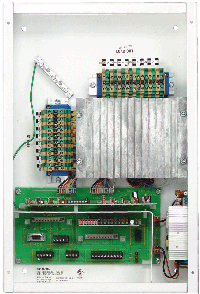
HCA has full support for the Lightolier Compose Protocol. Compose is used by the Lightolier CP dimmers and keypads, CI individual room dimmers, and the Compose PLC Firewall. This protocol is similar to X10 but uses different commands.
The Compose Protocol is designed with one major goal: To ensure that X10 signals transmitted are received and acted upon. To this end each transmission is confirmed by it's intended recipient.
In addition to the wall mounted dimmers and keypads, the Lightolier System uses the Compose PLC Firewall. This device is designed to act as a filter, amplifier and repeater for each circuit in your home.
In HCA we provide support way beyond simple support of Compose codes. The Lightolier Compose system has a lot of subtlety. For example, even if the light is off you can see the last scene the light was set to, as well as remotely tell if it is on or off. In addition there are some commands that are best not confirmed - not to interfere with the action of the ramp up or down - and some that should always be confirmed. All of these features are described in the HCA Appendix for the Lightolier system (Appendix 4).
The bottom line on all of this, is that if you want to use the Lightolier Compose system, you need to use HCA. No other software gives you the fine control you need.
Finally, in addition to the dimmers, keypads, and the firewall, the system in your home can use a communications board in the firewall for execution of time based events. This board, with it's processor and memory, can be controlled using a Lightolier TimeClock Remote or directly from HCA. HCA schedules can be translated and downloaded into the communications board for operation without the computer.
More information on the Compose system can be found on the Lightolier Controls website.
More information on how HCA works with the Lightolier Controls Compose System is found in the Lightolier HCA Appendix which can be downloaded from the Documentation section.
This support is only available in the Plus flavor of HCA.
 Top
Top

HCA works with all the powerline interfaces made by Marrick Ltd. This includes the LynX-10 (all models), the LynX-10 PLC and the LynX-PORT.
Depending upon the interfaced used, HCA provided complete support for all the features of the hardware. For example, when using the LynX-10PLC the LynX-Net protocol is used and configured from within HCA. HCA supplies a user interface for adjusting the transmission power and reception sensitivity of the LynX-10PLC.
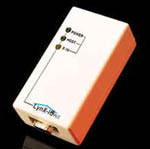
When using the LynX-PORT, HCA contains complete setup facilities to change the operation of the eight relays, inputs and analog channels. HCA programs can also modify the operation of the relays, inputs, and analog channels "on the fly". No other software available can do this. HCA also supports the LynX-PORT remote protocol to make changes to the boards operation using powerline signals.
More information on the Marrick Ltd. line of processors can be found on their Marrick Ltd. website.
More information on how HCA works with the Marrick Ltd. family of products can be found in the Marrick HCA Appendix which can be downloaded from the Documentation section.
Support for the Marrick Ltd. X10 processors is in the Standard and Plus flavors of HCA.
 Top
Top
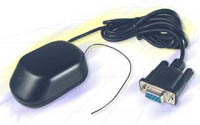
The MR26 is a interesting little gadget that receives signals from wireless keypads and from motion sensors and passes them directly to the computer. This can make processing those signals much faster.
HCA supports the MR26 and contains lots of setup features in processing signals received from the MR26. In addition to receiving the wireless signals, HCA can act as a transceiver to broadcast the signal on the powerline. This gets the signal into the computer much quicker and but still makes it available for devices on the powerline. All this is configurable on a housecode basis.
More information on the MR26 can be found on the X10 website.
How HCA uses the MR26 is described in the Wireless HCA Appendix which can be downloaded from the Documentation section.
Support for the MR26 is in the Standard, and Plus flavors of HCA.
While the MR26 is one cool product, it really lacks a good antenna. Here is a reference that will tell you how to get a better antenna. Either a do-it-yourself version or one assembled for you.
» A better antenna for the MR26
If you would like a more capable wireless receiver with a much better range, we suggest you look into the W800RF32.
 Top
Top
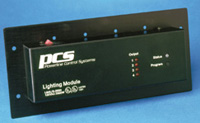
HCA supports all the X10 switches and lighting modules made by Powerline Control Systems (PCS). These switches and modules offer advanced dimming, local scene storage, and high reliability. Other features built into the switch provide for soft on and off, controllable response to all lights on, all lights off, all units off, and adjustable signal reception levels.
NOTE: Starting in HCA 6, support was added for the PCS PulseWorx line of UPB devices.
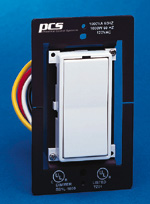
If you are looking for a lighting solution, you really must look into the PCS line. These switches are very capable with the ability to store sixteen scenes - a preset illumination level and a ramp rate. The lighting modules have 2 or 4 channels. In a scene, each channel can have a different illumination level and ramp rate - or not participate in the scene at all.
All that these great switches lack is good setup software. HCA provides that key piece!
Without HCA, programming of a scene is accomplished by manually sending the switch a long series of X10 commands. PCS provides complete documentation on how to do this but, simply put, it is arduous. HCA does this work for you. This allows you to concentrate on what you want - scene level lighting. With HCA you can finally get full function out of your switches without having to spend hours pressing buttons on X10 keypads.
More information on PCS switches and lighting modules can be found here.
The facilities in HCA for programming these products is available in the Programmable Devices HCA Appendix which can be downloaded from the Documentation section.
Support for PCS switch and module programming is in the Plus flavor of HCA.
 Top
Top

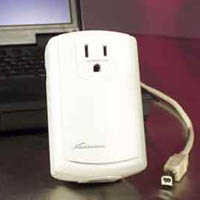
HCA supports many products available from SmartHome.
The serial PowerLinc and USB PowerLinc are power line interfaces that HCA can use to send and receive signals throughout your home. These interfaces are perfect for a small home and offer a low cost solution for cost conscious customers. These do not have a memory for downloaded schedules and programs.
Starting in HCA 7, support was added for the SmartHome line of Insteon devices. More information can be found on the Insteon Features page.
HCA also supported the USB PowerLinc Controller (1132CU) and Serial PowerLinc Controller. These products are very similar to the PowerLinc products but they do have a memory. HCA fully supports generating memory images for downloading to the PowerLinc Controller. In this way you can use HCA to download to the PowerLinc Controller and have it operate stand-alone, or you can download just your most important programs and schedules into the PowerLinc Controller and have HCA, running on your computer, handle the more complex stuff. Complete information on just what can and can't be downloaded to the PowerLinc Controller is covered in a X10 PowerLinc memory image construction Technical Note.
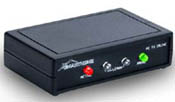
The PC to IR Linc allows HCA to send IR commands to any device who operates with an IR remote. Included in HCA are a full function IR Keypad builder so you can work with a keypad containing the keys you need and labeled in the appropriate manner. Using these keypads you can create HCA programs that control IR devices, and also schedule IR command sequences to be sent at any time you choose.
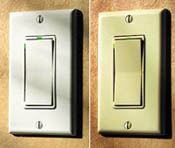
The SwitchLinc wall switch and LampLinc module are an advanced X10 controllable device that offers local scene storage (most but not all models), advanced dimming, and adjustable lighting ramp rates. To program these switches a series of X10 signals is sent to the switch. HCA contains a user interface that makes it significantly simpler to setup the switch. This way you get the switches programmed without spending hours sending X10 signals from a keypad.

Finally, HCA supports the old HouseLinc. This interface is capable of sending and receiving X10 signals, sending IR signals, and contains a processor and memory for independent operation. Setup for the IR features of the HouseLinc is a bit more involved than the IRLinc but is fully supported by HCA.
Using the HCA download wizard you can select programs and schedules for download to the HouseLinc. HCA translates the selected schedules and graphical programs into the internal codes required by the HouseLinc and performs the download for you. Any features of HCA programs and schedules that can't be translated to the HouseLinc are noted.
No other software available supports these SmartHome products are completely as HCA.
More information on these SmartHome.com products can be found here:
The facilities in HCA for programming SwitchLinc switches is available in the Programmable Devices HCA Appendix and the HouseLinc and IRLinc are described in SmartHome HCA Appendix. Both appendixes can be downloaded from the Documentation section.
Support for programming SwitchLinc switches is in the Plus flavor of HCA. Support for the HouseLinc and IRLinc is in the Standard and Plus flavors of HCA.
 Top
Top
Copyright © 2002-2024 Advanced Quonset Technology, Inc. All Rights Reserved.
A Welsolutions site
